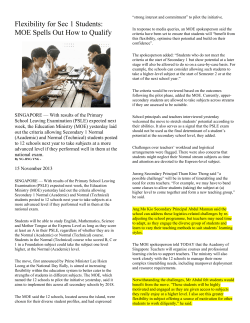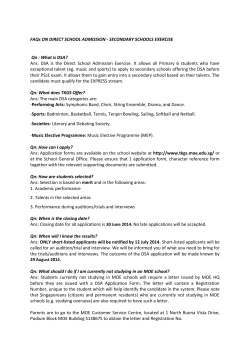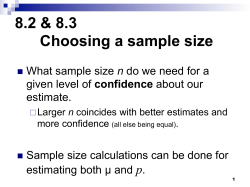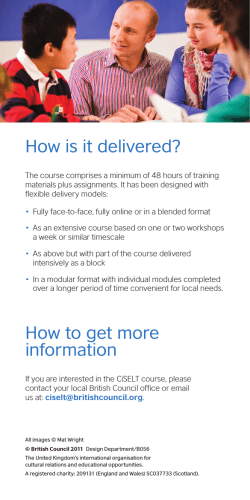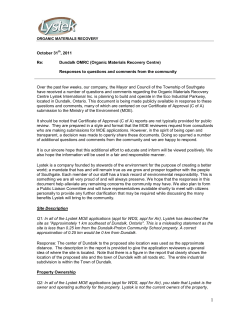
Sample Pages
Sample Pages Sample pages from this product are provided for evaluation purposes. The entire product is available for purchase at www.socialstudies.com or www.goodyearbooks.com To browse eBook titles, visit http://www.goodyearbooks.com/ebooks.html To learn more about eBooks, visit our help page at http://www.goodyearbooks.com/ebookshelp.html For questions, please e-mail [email protected] Free E-mail Newsletter—Sign up Today! To learn about new eBook and print titles, professional development resources, and catalogs in the mail, sign up for our monthly e-mail newsletter at http://www.goodyearbooks.com/newsletter/ For more information: 10200 Jefferson Blvd., Box 802, Culver City, CA 90232 Call: 800-421-4246 • Fax: 800-944-5432 (U.S. and Canada) Call: 310-839-2436 • Fax: 310-839-2249 (International) Copyright notice: Copying of the book or its parts for resale is prohibited. Good Year Books Click here to find additional titles. www.goodyearbooks.com 48 Decidedly Different Creative Writing Prompts Aligns to NCTE Standards Mark H. Larson and Robert S. Boone Good Year Books Culver City, California From 'Moe's Cafe'. Product code GDY402. Good Year Books. (800) 421-4246. http://www.goodyearbooks.com/ From MOE'S CAFE http://www.goodyearbooks.com/c/product.html?record@TF43503 Dedication To the memory of Professor Wallace W. Douglas of Northwestern University: “The mind boggles.” Good Year Books Our titles are available for most basic curriculum subjects plus many enrichment areas. For more Good Year Books, contact your local bookseller or educational dealer. For a complete catalog with information about other Good Year Books, please contact: NCTE Standards Moe’s Café: 48 Decidedly Different Creative Writing Prompts contains lessons and Good Year Books 10200 Jefferson Boulevard Culver City, CA 90232-0802 www.goodyearbooks.com activities that reinforce and develop skills Library of Congress Catloging-in-Publication Data Larson, Mark. Moe’s café : 48 decidedly different creative writing prompts / Mark H. Larson, Robert S. Boone. p. cm. ISBN-13: 978-1-59647-088-0 meet the NCTE standards regarding as defined by the National Council of Teachers of English as appropriate for students in grades 6 to 12. These activities 1. English language--Compostion and exercises-Study and teaching (Middle school)--United States. 2. Creative writing (Middle School)--United States. I. Boone, Robert S. II. Title. LB1631.L263 2006 808'.040712--dc22 2006043473 Copyright ©2007 Robert S. Boone and Mark Henry Larson. Printed in the United States of America. All Rights Reserved. ISBN-13: 978-1-59647-088-0 ISBN-eBook: 978-1-59647-149-8 literary range, periods/genres, textual analysis, voice, audience, form/technique, research, technology, diversity, and purpose. See www.goodyearbooks.com for information on how specific lessons correlate to specific standards. Cover Design: Gary D. Smith, Peformance Design Text Design: Doug Goewey Cover photo: 300dpiGuy, courtesy iStock.com Interior photos: page 3 — 300dpiGuy, courtesy iStock.com page 53 — Nancy Louie, courtesy iStock.com page 103 — Christine Balderas, courtesy iStock.com 1 2 3 4 5 6 7 8 9 ML 13 12 11 10 09 08 07 06 No part of this book may be reproduced in any form or by any means, except those portions intended for classroom use, without permission in writing from the publisher. From 'Moe's Cafe'. Product code GDY402. Good Year Books. (800) 421-4246. http://www.goodyearbooks.com/ From MOE'S CAFE http://www.goodyearbooks.com/c/product.html?record@TF43503 From Moe’s Café, Copyright © Good Year Books. This page may be reproduced for classroom use only by the actual purchaser of the book. www.goodyearbooks.com. It All Started with Moe ... ABOUT TWENTY YEARS AGO I was teaching a creative writing workshop to a group of ninth graders from Chicago’s South Side. On this first meeting of a four-session program, the students were to describe a real or imaginary place. I told them to select a “memorable” place and make the readers feel they were there. I told them to follow a plan and to pack in plenty of details. I even read a few examples from former students. Description, I told the group, is something all writers need to master! They all nodded but not agreeably. In fact, you might say that they nodded disagreeably. Instead of smiling, they scowled. Instead of sitting up eagerly, they slumped. Instead of asking me pertinent questions, they grumbled. Even the teacher who had arranged for this workshop sat in the back with a John Grisham novel nestled in her lap and yawned. This was not going to be pretty. What to do? Should I push forward even though prospects did not look good, or should I try this new idea I had been fiddling with? I looked over as the teacher was picking up her novel and made the choice. What’s there to lose?, I thought. Let’s see what happens. OK, I told the group, change of plan. Imagine that you’re inside a horrible restaurant called “Moe’s Café.” I’m going to ask you a dozen questions. You’ll scribble down quick answers. When I’m done asking, you’ll take your answers and shape them into your description. Before they had a chance to complain, I began firing off questions: What’s on the floor? How about the menu? What do you see on the wall? Name several bad smells. Where’s Moe standing? What’s he look like? What about that dog sleeping in the corner? How about the family that sat down next to you? By now they were sitting up and smiling, and I could tell I was on to something. When they told me to slow down, I sped up and asked more questions: How about Blanche the waitress? What can you tell me about the ceiling? Before long I was done asking questions, and they were about to begin composing. I told them that they should write this description as a letter to a friend and that they could change the order of details or add some more. Then I shut up and let them write. For an hour they were bent over, feverishly carving out their descriptions while I sat on the desk and marveled. Even the yawning teacher had put down John Grisham and was scribbling away. When they were done, they read aloud and the results were gruesomely spectacular. One girl talked about a dead fly on the menu. Another girl described the barefoot waitress’s big toe. A boy added a contrasting detail: an old lady in a white dress carefully nibbling a sandwich at a corner table. Each description was powerful in its own way. Most were funny, but a few were quite sad. Moe’s Café was born. Over the next three sessions, I continued with the Moe Method: I put the students into a place; I asked a lot of questions. They listened, scribbled, and composed. In Session Two, they described a cozy cabin. In Session Three it was a spooky office. Session Four was a barn with a cat about to do in a mouse. On my last day, I suggested to the regular teacher that she might want to continue doing this. She said that she had already started a list, thank you. As I asked the class to think about their recent writing, I pointed out that although I may have been the one who asked the questions, they were the ones who did the actual writing, and it was very good. From now on when you write, I urged them, ask your own questions. Through the years I have continued to teach writing workshops all over the Chicago area and have founded a program for city kids who like to write. In all of these efforts, Moe and his despicable dump have been at my side. No matter whom or where I taught, I would always ask my writers to stop in first at Moe’s Café. Now fellow Moe’s regular Mark Larson and I have put together a book of writing ideas inspired by Moe’s Café. The prompts are varied: Some require imagination; others require memory. They all, however, involve a heavy dose of questions and answers. As Moe himself might have said, “You ain’t going to write something until you have something to write. Hot cap on that coffee?” Bob Boone Founder, Young Chicago Authors Mark Henry Larson Northwestern University Center for Talent Development Preface From 'Moe's Cafe'. Product code GDY402. Good Year Books. (800) 421-4246. http://www.goodyearbooks.com/ iii From MOE'S CAFE http://www.goodyearbooks.com/c/product.html?record@TF43503 Contents Introduction Your Historical Favorite To the Teacher . . . . . . . .................................................... 1 Meeting a Challenge .............................................. 64 To the Young Prose Writer Life’s Not Always Fair ............................................ 66 1 Part One: Making Things Up ................ 3 Moe’s Café . . . . . . . . . . . . . .................................................... 4 Mr. Jones’s Bad Day ................................................. 6 The Final Shot Hot Tuesday . . . . . . .................................................... . . . . . . . . . . .................................................. High Drama in the Barn A Distant Land 8 10 ...................................... 12 . . . . . .................................................. 14 Eccentric on the Bus .............................................. 16 Someone’s Cheating Leon the Loner .............................................. 18 . . . . . .................................................. 20 Priscilla the Pessimist Juan’s New Job ............................................ 22 . . . . . . .................................................. 24 Too Much Person Wacky Situation . .................................................. 26 . . . .................................................. 28 Brenda’s Solution . .................................................. 30 Coach’s Dilemma . .................................................. 32 Burned-out Teacher Betrayal .............................................. 34 . . . . . . . . . . . . . . . . . . .................................................. 36 A Fiasco .................................................................... Fooled by Appearances ......................................... 62 68 70 Learning Outside of School ................................. 72 Loyalty Tested ......................................................... Brand-New World Quite a Trip 74 ................................................. 76 ............................................................. 78 A Disagreement ...................................................... 80 Surprising Folks ..................................................... A Revealing Place School Days 82 ................................................... 84 ............................................................. 86 Back to School ........................................................ 88 Favorite Stories ....................................................... 90 Lost and Found ...................................................... 92 ....................................................................... 94 Gossip Building a Buddy ................................................... Distant Role Model Farewell ............................................... .................................................................. Where Do You Go from Here? ........ 96 98 100 103 Playing Parent . . . . . . . .................................................. 38 Simple-Sentence Prompts .................................. 104 Teacher Done You Wrong One Final Story Luck at the Beach .................................... 40 . .................................................. 42 Risking It All for a Friend False Charge .................................... 44 . . . . . . . . . . .................................................. 46 Gatsby . . . . . . . . . . . . . . . . . . . . . .................................................. 48 Grandma Reconsiders ........................................... 50 Part Two: Remembering Things iv Samples of Student Writing “A Stranger’s Request” by Ariel Ranieri ......... 107 “Hey, Tom” by Dan Kiefer ................................. 110 “Electricity” by Carlos Angelos ........................ 112 “Evanescence” by Mahesh Vallath ................... 114 ................... 116 53 “Ring, Ring, Ring” by Jesse Welch ............................... 54 “Visiting York” by Kate Burgoon ..................... 118 . . . . . . . . .................................................. 56 “The Dare” by Naina Chandan ........................ 120 ................................................ 58 . . . . . . . .................................................. 60 “When I Climb into Trees” by Jillian Avalon ............................................ 122 Savvy Acquantance One of a Kind 106 ...... Old Acquaintance/New Role Great Teacher .................................................... Contents From 'Moe's Cafe'. Product code GDY402. Good Year Books. (800) 421-4246. http://www.goodyearbooks.com/ From Moe’s Café, Copyright © Good Year Books. This page may be reproduced for classroom use only by the actual purchaser of the book. www.goodyearbooks.com. ..................................... ....................................... From MOE'S CAFE http://www.goodyearbooks.com/c/product.html?record@TF43503 Introduction From Moe’s Café, Copyright © Good Year Books. This page may be reproduced for classroom use only by the actual purchaser of the book. www.goodyearbooks.com. To the Teacher We are excited about this book for many reasons, not the least of which is that we are anxious to use it ourselves with our own students. Although designed to be used as the primary text for a creative writing course, the book can be easily adapted for use as a component to a general English course, as a guide for a creative writing club, or as a workbook for a selfdirected or tutored individual. The two biggest strengths of this book are its effectiveness and its versatility. We know that both this method and these exercises work because we have used them ourselves in a number of diverse settings within and beyond the traditional classroom. They have worked with pre-teens, teens, and adults. They have worked with highly motivated college-bound kids, with “at-risk” students placed in alternate school settings, with adults in writing workshops, with individual students working online, and with creative writing clubs. Because the forty-eight prompts do not necessarily need to be taught in sequence, you can feel free to pick and choose those that appeal to you and your students. Most of the activities can be done with or without a teacher’s presence, and the balance can be adjusted between in-class work and homework assignments as the teacher sees fit. This makes them especially useful for those times when you wish to conference with individuals or on those days when a substitute teacher is handling your class. A possible weekly sequence could be set up as follows: Monday: Read prompt (Start). Answer ten questions (Questions). Organize material (Getting Ready). Share results. Homework: Write mini-stories (Starting Your Story). Tuesday: Share mini-stories. Homework: Read suggested short story (Read and Write). Wednesday: Discuss short story. Begin drafting (Write Away). Homework: First draft (Write Away!). Thursday: Peer edit drafts. View and discuss film scene (On the Screen). Homework: Revise draft. Friday: Share and discuss drafts. Although the lessons do work by themselves—we use a number of them “as is” for our online creative writing course—they are more fun and effective when you yourself become involved in the question process. This provides you with an opportunity to branch off and supplement these questions with more of your own—especially as your students become more excited about their creations. Each lesson also contains suggestions for short stories and film scenes that are closely connected to the story prompts. In a creative writing course, these may be used as writing models and discussion starters for the individual prompts. These same story and film suggestions could form the curriculum of a short story and/or film study unit or component in a general English foundations course. Most of the short story selections are gleaned from commonly found school anthologies and/or accessible online short story sites. Keeping in mind the legal restrictions of showing certain films in the classroom, we have only included films that are rated G, PG, or PG-13 in our film selections. Though the films could be viewed in their entirety, specific scenes have been earmarked for analysis so that the exercise need not use up more class time than you can afford. Good luck and welcome to Moe’s—the pie is great, but watch out for the chili. To the Young Prose Writer There are several possible reasons why you may now own this book. Maybe you are taking a creative writing course and you had to buy it. Perhaps you are intrigued by the short story form and want to try your hand at writing some Poe-like thrillers, science fiction adventures, or social reality scenarios on your own. You may even be a creative writer already and want to continue something you already have going. In any case, you must have decided that creative writing matters, that it is something you want to do well. Maybe you want to be a writer, or maybe you just want to find out if you want to be a writer. Maybe you are a different kind of writer, but you think creative writing will help you develop other skills. Although creative writing shares many similarities with other types of writing, it does differ in some important respects from most of the writing done in schools. In English class, you frequently write about literature: You make statements, which you then prove by citing examples from your reading or research. Your work is evaluated according to how clearly, convincingly, and correctly you make your point. Introduction From 'Moe's Cafe'. Product code GDY402. Good Year Books. (800) 421-4246. http://www.goodyearbooks.com/ 1 With creative writing, however, instead of analyzing poems or stories, you actually write the poems and stories yourself. Your material comes from your imagination and memory. Instead of being as clear and direct as possible, you try to be more subtle and indirect. In some cases, how you write will be more important than what you write. Instead of appealing to your readers’ sense of logic, you must also appeal to their feelings. You expect more of your audience. Like most creative writing books, this one has many prompts to help you to get started. Unlike the prompts in most other books, though, these prompts include lots of questions for you to answer before you get started. These questions are designed to help you think deeply and creatively about your subject beforehand. Once you have answered these questions, you should be ready and anxious to write. Another unique feature of the “Moe method” is the “mini-story” approach. After the questions have helped you to think a bit about a particular story, you will write several ninety-word mini-stories. These mini-stories are either basic plot summaries or short excerpts of possible full-length versions of your story. By experimenting with these very short versions, you will quickly get an idea of what story approach will work best for you. Most writers do some sort of trialand-error method like this before they decide on how to approach their stories. Imagine a group of television or film writers kicking around ideas for a possible new television pilot or movie: “There’s this poor artist and this beautiful girl that love each other, but her mom wants her to marry this rich jerk. They could both be on the Titanic and she has to sneak away. . . .” The method is fast, fun, and effective. In addition, each prompt suggests a short story to read and a film scene to watch that bear a close connection in theme, situation, character, or style to the story that you are writing. Each story and film suggestion includes specific advice to help you concentrate on the piece as a writer. By examining these stories and scenes, you will have a chance to compare your own work with that of professionals who have taken on similar writing challenges. Along with these professional models, the book also includes several completed short stories written by writers your age. These stories were written in response to the same prompts found in the book and provide further ideas for what makes for a successful story. Before you get started writing, it is important to establish the basic definition of a short story and the terms associated with it. First, a familiarity with these literary terms will provide a common vocabulary for 2 describing the elements that should be included within your story. Next, these same elements will provide a basic framework for the critical questions you will ask yourself as you go back to improve your work. The short story is a relatively short piece of prose fiction, narrated from a single point of view and taking place in a distinctive setting. It has a series of actions or plot built around a central issue or conflict. Usually this involves at least one character whose life may be significantly changed once the issue is resolved. The tone of a short story can be funny or serious, realistic or fantastic, straightforward or satiric. The story can be strictly entertaining or much more thematic. The following questions will first serve as a descriptive guide as to what should be included within your story, then afterward they will serve as a critical guide as to what to consider in your revision process: Point of View • Is the right person telling the story? Setting • • • • • • Characters Does the story start where it should? Is the conflict clear? Does it build to a climax? Is there suspense? Does the conflict resolve itself? Does it end where it should? • Are the characters well developed? • Are they motivated? • Do their actions push the story along? • Do the minor characters serve a specific purpose? Theme • If there is supposed to be a theme, is it apparent? • Is it subtle? Style • Is the writing clear? • Is the language appropriate for the speaker? Now get ready to write. In the first prompts you will rely on your imagination as you find yourself walking in strange places or facing tough decisions or encountering unusual people. In the second group of prompts, you will explore your own memories for further ideas. Good luck and good writing! Introduction From 'Moe's Cafe'. Product code GDY402. Good Year Books. (800) 421-4246. http://www.goodyearbooks.com/ From Moe’s Café, Copyright © Good Year Books. This page may be reproduced for classroom use only by the actual purchaser of the book. www.goodyearbooks.com. From MOE'S CAFE http://www.goodyearbooks.com/c/product.html?record@TF43503 From MOE'S CAFE http://www.goodyearbooks.com/c/product.html?record@TF43503 From Moe’s Café, Copyright © Good Year Books. This page may be reproduced for classroom use only by the actual purchaser of the book. www.goodyearbooks.com. Part One Making Things Up 3 From 'Moe's Cafe'. Product code GDY402. Good Year Books. (800) 421-4246. http://www.goodyearbooks.com/ From MOE'S CAFE http://www.goodyearbooks.com/c/product.html?record@TF43503 Moe’s Café u Start You’re driving some place far from home when your radiator starts steaming. You manage to find a mechanic at a gas station who can fix your car, but it’s going to take a few hours. You ask him if there’s any place to get a bite, and he points across the road to Moe’s Café. You don’t have much choice, so you head inside and take a seat at the first booth on the left and look around in horror at the filth. ? Questions After reading the prompt above, answer the following questions on another sheet of paper. Use your answers to help you think about your subject. 1. What does the floor look like? 6. What six specific smells can you identify? 2. What’s on the menu? 3. Who does Blanche, the waitress, resemble? 7. Moe is cooking behind the counter. What does he look like? 4. What’s hanging on the walls? 8. You spot Barney, Moe’s dog, in the corner. What is he doing? 5. What’s playing on the jukebox? On the TV? 9. Who are the people sitting in the next booth? What are they talking about? 10. Blanche brings your food. What does it look like? 4 Part One: Making Things Up From 'Moe's Cafe'. Product code GDY402. Good Year Books. (800) 421-4246. http://www.goodyearbooks.com/ From Moe’s Café, Copyright © Good Year Books. This page may be reproduced for classroom use only by the actual purchaser of the book. www.goodyearbooks.com. A detailed description of a place with personality From MOE'S CAFE http://www.goodyearbooks.com/c/product.html?record@TF43503 From Moe’s Cafe, Café, Copyright © Good Year Books. This page may be reproduced for classroom use only by the actual purchaser of the book. www.goodyearbooks.com. 3 P Getting Ready Write Away! In a few sentences, capture the look and the feel of Moe’s Café. 1. Pick the mini-story you like most and make it longer. Consider flashing back to relevant events in your narrator’s earlier life. Starting Your Story Now that you have visited Moe’s Café, write three ninety-word mini-stories. You’ll have to decide who will tell the story, where it will start, and if the tone will be serious or comic. Here are some possibilities. 1. Moe comes up to your table and offers to sell you the place for $200. 2. The waitress whispers to you that she is being held captive. 3. The police charge in and break up an illegal gambling operation in the back. 4. The lady at the table next to you turns out to be your long-lost sister. 5. You find a treasure map on the floor. 6. You play a song on the jukebox and a woman at the counter starts screaming. 7. You suddenly discover a solution to a problem that has been bothering you for months. OR: Come up with your own idea for a mini-story. 2. Study your new draft and consider the following: Do the characters seem real? What motivates them? Is there some suspense? Does the setting contribute to the story line? 3. Write the final draft. Read and Write Consider reading “A & P” by John Updike, another story in which the setting—in this case a grocery store on the outskirts of a resort community— has a significant effect on the action of the story. Notice how the narrator’s “overfamiliarity” with his surroundings contributes to a life-affecting decision. Then create your own story set in a “place with a personality.” On the Screen Watch Star Wars: Episode IV (rated PG) and pay particular attention to the saloon scene on the planet Tatooine. Notice how director George Lucas’s attention to detail makes this an unforgettable setting. Today’s Special Want to see how another student used this prompt to begin a full story? See “Hey, Tom” on page 110. Moe’s Café From 'Moe's Cafe'. Product code GDY402. Good Year Books. (800) 421-4246. http://www.goodyearbooks.com/ 5
© Copyright 2025
